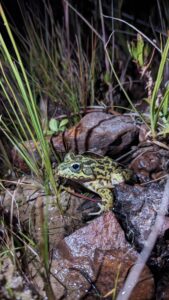
Cape river frog, South Africa
Welcome Dr. Maggie Doolin, NSF postdoctoral fellow and Environmental Biology graduate students Peyton Haifley and Alexander Richards as well as Integrative Biology graduate student Kaitlyn Williams!
see people page

Cape river frog, South Africa
Welcome Dr. Maggie Doolin, NSF postdoctoral fellow and Environmental Biology graduate students Peyton Haifley and Alexander Richards as well as Integrative Biology graduate student Kaitlyn Williams!
see people page
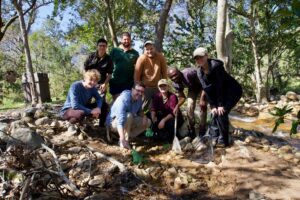
Field crew sampling wild Xenopus laevis in South Africa
The “Goo-Crew” sampled wild African clawed fogs, also known as Common platanna (Xenopus laevis), for skin microbes and defense peptides as well as pathogen diagnostics in wild habitats at Jonkershoek Nature Reserve. They worked in collaboration with Martine Jordaan (Cape Nature), Dr. John Measey (invasion biologist from the University of Stellenbosch), and guided by Andre De Villiers with field assistance from Jean Damascene Niyonzima and Julia MacDonald.
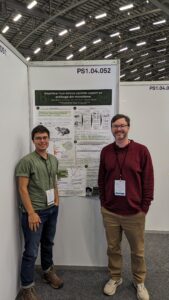
Poster by Nina McDonnell presented at ISME19
At ISME19 in Cape Town, South Africa the Woodhams lab presented research by Dr. Patrick Kearns, Nina McDonnell and Dr. Doug Woodhams. A highlight was the talk by Dr. Kearns on “Multicontinent analysis of amphibian associated Janthinobacterium lividum genomes reveals strong host selection on gene content,” funded by the NSF Biology Integration Institute RIBBITR.

Overlooking the Zürichsee at Wädenswil, Switzerland
At the Drug Discovery Symposium in Switzerland, Dr. Woodhams presented on “The Amphibian Microbiome and Disease Resilience,” at an event honoring the retirement of Dr. Martin Seivers, co-founder of the Culture Collection of Swizerland (CCOS). The Woodhams lab has archived amphibian skin bacteria in this collection and is working to understand the antifungal mechanisms and products of amphibian skin bacteria.
 In this study, we used radiotelemetry and translocations to track microbiome composition and function, pathogen infection, and host stress over time across natural movement paths for the forest-associated treefrog, Boana faber. We found strong integration of host stress response and anti-pathogen potential of the microbiome. Additionally, we observed a capacity for resilience (resistance to structural change and functional loss) in the amphibian skin microbiome, with maintenance of putative pathogen-inhibitory function despite major temporal shifts in microbiome composition.
In this study, we used radiotelemetry and translocations to track microbiome composition and function, pathogen infection, and host stress over time across natural movement paths for the forest-associated treefrog, Boana faber. We found strong integration of host stress response and anti-pathogen potential of the microbiome. Additionally, we observed a capacity for resilience (resistance to structural change and functional loss) in the amphibian skin microbiome, with maintenance of putative pathogen-inhibitory function despite major temporal shifts in microbiome composition.
Neely WJ, Martins RA, Mendonça da Silva CM, Ferreira da Silva T, Fleck LE, Whetstone RD, Woodhams DC, Cook WH, Prist PR, Valiati VH, Greenspan SE, Tozetti AM, Earley RL, Becker CG. 2023. Linking microbiome and stress hormone responses in wild tropical treefrogs across continuous and fragmented forests. Communications Biology, 6(1):1261. doi: 10.1038/s42003-023-05600-9.
Read this article.
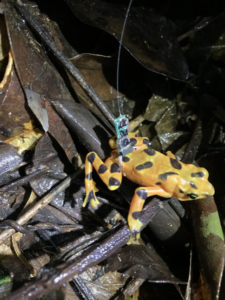
Variable harlequin frog Atelopus varius fitted with a 0.3 g radio transmitter.
 I am thrilled to share that our entry has been chosen as one of the nine winners of Cerillo’s 2023 Co-Culture Champion Contest. This recognition is incredibly meaningful, especially considering there was a diverse array of entries from around the globe. We’re looking forward to using Cerillo’s Co-Culture Duet System to simulate natural amphibian skin conditions to potentially revolutionize therapies for threatened amphibians and their conservation. You can learn more about our winning entry here: https://cerillo.bio/co-
I am thrilled to share that our entry has been chosen as one of the nine winners of Cerillo’s 2023 Co-Culture Champion Contest. This recognition is incredibly meaningful, especially considering there was a diverse array of entries from around the globe. We’re looking forward to using Cerillo’s Co-Culture Duet System to simulate natural amphibian skin conditions to potentially revolutionize therapies for threatened amphibians and their conservation. You can learn more about our winning entry here: https://cerillo.bio/co-
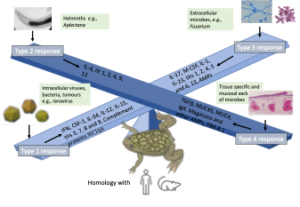
Immune equilibrium modeled as balance beams after Eberl (2016).
Microbiota including pathogens of the frog Xenopus laevis may bias immune responses at early stages of development such that the microbiome and infection susceptibility will be altered in later life.
In this 3 year NIH-funded project we will utilize germ-free conditions for raising tadpoles and monitoring immune responses and microbiota on the skin and mucus.
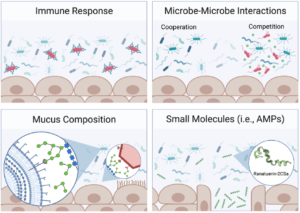
The microbiome interacts with multiple aspects of the amphibian skin landscape.
We review amphibian skin mucus components and describe the adaptive microbiome as a novel process of disease resilience where competitive microbial interactions couple with host immune responses to select for functions beneficial to the host.
Woodhams DC, McCartney J, Walke JB, Whetstone R. 2023. The Adaptive Microbiome Hypothesis and Immune Interactions in Amphibian Mucus. Developmental and Comparative Immunology, 145:104690.
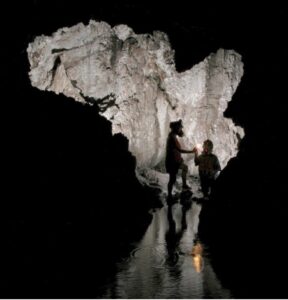
https://www.caveslime.org/
Dr. Pat Kearns leads analysis of bat mycobiomes.
Kearns PJ, Winter AS, Woodhams DC, Northup DE. 2023. The mycobiome of bats in the American southwest is structured by geography, bat species, and behavior. Microbial Ecology, 86(3):1565-1574.